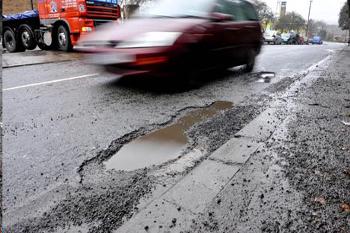The Government should bolster guidance and standards in the local highways sector to help address a major loss of expertise since the start of austerity, a key industry body has warned.
The Road Surface Treatments Association (RSTA) has called for a national statutory standard definition of a pothole, warning that ‘cash-strapped local authorities may move the goalposts in order to try to save money by not repairing smaller potholes’.

To be or not to be a pothole?
The warnings follow the news that Perth and Kinross Council has recently redefined its classification of a pothole and declared they must now be 60mm deep – an increase of 50% from its previous 40mm classification – before they are repaired and filled.
A council spokesman said: 'The council agreed when setting its budget for 2016/17 to implement the increased intervention levels for repairs from 40mm to 60mm. To ensure safety, we will continue to undertake repairs in inherently dangerous circumstances as part of a risk assessment approach.'
In a statement, the RSTA said: 'The lack of a national pothole definition means that we have a postcode lottery of road repair as different local authorities take different approaches. There is no consistency.
'Under the Road Traffic Act 1980 all local highway authorities have a duty of care to maintain their road network but there is no national definition or agreement as to when a pothole is a pothole.'
The news comes as the current national code of practice for highways maintenance - Well-maintained Highways, which does not provide a national definition of potholes - is under review, with a new version set to be released by Christmas.
Well-managed Highways Infrastructure, which is set to replace the current code, will bring in a risk-based approach to asset maintenance and is likely to remove the concept of national standards, the sector has been told.
Speaking to Transport Network, RSTA chief executive Howard Robinson, said: ‘We have lost a lot of expertise when it comes to highways maintenance. Taking a risk-based approach on one hand would be sensible but we need standards around competency. If we are assessing risk we have to be confident in the competency of those assessing the risk.
‘It might be a case that we need a standardised approach to fixing potholes. It’s been going round the houses for a number of years. Taking a risk-based approach is commendable but we have to have a yardstick or metric to assess the risk. It is very strange as the highways sector is engulfed in standardisation.’
Mr Robinson said he not have a readymade definition of a pothole but added that one could be established by joint working across the sector and industry to produce guidance on the issue.
‘Developed jointly, this could put in place simple guidance to allow inexperienced personnel to spot when a pothole is emerging and could become hazardous, which is missing at the moment,’ he said.
Mr Robinson added that if councils wished to check contractors' skills it could ensure that they are certified against the Sector Scheme Document 23 for 'Small Scale Pavement Repairs'.
When a pothole is a pothole (RSTA figures):
Gloucestershire - a road surface defect becomes a pothole if it is 40mm deep and 30cm wide
Worcestershire - a defect must be 40mm deep but 20cm wide
Bath and NE Somerset - a defect must be 30mm deep to be accepted as being a pothole
Hounslow, London - a pothole will only be repaired urgently if it reaches 75mm
Warwickshire - a pothole of up to 50mm is not considered to be hazardous and will only be repaired as part of routine maintenance six months after being reported. Potholes up to 100mm will take up to 28 days to be repaired
Trafford - a pothole warrants repair at 40mm in depth
Herefordshire County Council - aims to record and treat all potholes regardless of depth
Register now for full access
Register just once to get unrestricted, real-time coverage of the issues and challenges facing UK transport and highways engineers.
Full website content includes the latest news, exclusive commentary from leading industry figures and detailed topical analysis of the highways, transportation, environment and place-shaping sectors.
Use the link below to register your details for full, free access.
Already a registered? Login